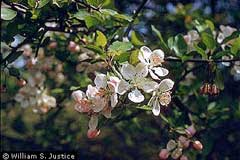 |
|
William S. Justice @ USDA-NRCS PLANTS Database |
 |
|
Translate this page:
Summary
Bloom Color: Pink, White. Main Bloom Time: Early spring, Late spring, Mid spring. Form: Oval, Rounded, Upright or erect, Weeping.
Physical Characteristics

 Malus_angustifolia is a deciduous Tree growing to 7 m (23ft) at a medium rate.
Malus_angustifolia is a deciduous Tree growing to 7 m (23ft) at a medium rate.
See above for USDA hardiness. It is hardy to UK zone 6 and is not frost tender. It is in flower from April to May. The species is hermaphrodite (has both male and female organs) and is pollinated by Insects.
It is noted for attracting wildlife.
Suitable for: light (sandy), medium (loamy) and heavy (clay) soils, prefers well-drained soil and can grow in heavy clay soil. Suitable pH: mildly acid, neutral and basic (mildly alkaline) soils. It can grow in semi-shade (light woodland) or no shade. It prefers moist soil.
UK Hardiness Map
US Hardiness Map
Synonyms
Plant Habitats
Edible Uses
Fruit - raw or cooked[61, 105]. A fragrant aroma, but the fruit is harsh and acid[11]. The hard sour fruits are often used for making preserves, cider, jellies etc[46, 82, 183]. The fruit is about 25mm in diameter and is slightly pear-shaped[200].
References More on Edible Uses
Medicinal Uses
Plants For A Future can not take any responsibility for any adverse effects from the use of plants. Always seek advice from a professional before using a plant medicinally.
None known
References More on Medicinal Uses
The Bookshop: Edible Plant Books
Our Latest books on Perennial Plants For Food Forests and Permaculture Gardens in paperback or digital formats.

Edible Tropical Plants
Food Forest Plants for Hotter Conditions: 250+ Plants For Tropical Food Forests & Permaculture Gardens.
More

Edible Temperate Plants
Plants for Your Food Forest: 500 Plants for Temperate Food Forests & Permaculture Gardens.
More

More Books
PFAF have eight books available in paperback and digital formats. Browse the shop for more information.
Shop Now
Other Uses
Wood - hard, heavy, close grained[46, 61, 82, 229]. It weighs 43lb per cubic foot[235]. Of no commercial value, but it is used locally for making levers, tool handles and other small objects[46, 61, 82, 229].
Special Uses
References More on Other Uses
Cultivation details
Landscape Uses:Border, Specimen. An easily grown plant, it succeeds in most fertile soils, preferring a moisture retentive well-drained loamy soil[1, 200]. Grows well in heavy clay soils. Prefers a sunny position but succeeds in partial shade though it fruits less well in such a situation[1, 200]. The flowers have a perfume of violets[245]. A short-lived tree in the wild[229]. The fruit is a good wildlife food source, especially for birds[200]. Hybridizes freely with other members of this genus[200]. Plants in this genus are notably susceptible to honey fungus[200]. Special Features:North American native, Fragrant flowers, Attractive flowers or blooms.
References Carbon Farming Information and Carbon Sequestration Information
Temperature Converter
Type a value in the Celsius field to convert the value to Fahrenheit:
Fahrenheit:
The PFAF Bookshop
Plants For A Future have a number of books available in paperback and digital form. Book titles include Edible Plants, Edible Perennials, Edible Trees,Edible Shrubs, Woodland Gardening, and Temperate Food Forest Plants. Our new book is Food Forest Plants For Hotter Conditions (Tropical and Sub-Tropical).
Shop Now
Plant Propagation
Seed - best sown as soon as it is ripe in the autumn in a cold frame. It usually germinates in late winter. Stored seed requires stratification for 3 months at 1°c and should be sown in a cold frame as soon as it is received[200]. It might not germinate for 12 months or more. Prick out the seedlings into individual pots as soon as they are large enough to handle. If given a rich compost they usually grow away quickly and can be large enough to plant out in late summer, though consider giving them some protection from the cold in their first winter. Otherwise, keep them in pots in a cold frame and plant them out in late spring of the following year. Cuttings of mature wood, November in a frame[11].
Other Names
If available other names are mentioned here
Native Range
NORTHERN AMERICA: United States (New Jersey (south), Ohio (south), West Virginia, Illinois (south), Alabama, Arkansas, Delaware, Florida, Georgia, Kentucky, Louisiana, Maryland, Mississippi, North Carolina, South Carolina, Tennessee, Virginia, Texas)
Weed Potential
Right plant wrong place. We are currently updating this section.
Please note that a plant may be invasive in one area but may not in your area so it’s worth checking.
Conservation Status
IUCN Red List of Threatened Plants Status :

Growth: S = slow M = medium F = fast. Soil: L = light (sandy) M = medium H = heavy (clay). pH: A = acid N = neutral B = basic (alkaline). Shade: F = full shade S = semi-shade N = no shade. Moisture: D = dry M = Moist We = wet Wa = water.
Expert comment
Author
(Aiton.)Michx.
Botanical References
1143200
Links / References
For a list of references used on this page please go here
Readers comment
| Add a comment |
|
If you have important information about this plant that may help other users please add a comment or link below. Only comments or links that are felt to be directly relevant to a plant will be included. If you think a comment/link or information contained on this page is inaccurate or misleading we would welcome your feedback at [email protected]. If you have questions about a plant please use the Forum on this website as we do not have the resources to answer questions ourselves.
* Please note: the comments by website users are not necessarily those held by PFAF and may give misleading or inaccurate information.
To leave a comment please Register or login here All comments need to be approved so will not appear immediately.
|
Subject : Malus_angustifolia
|
|
|
|